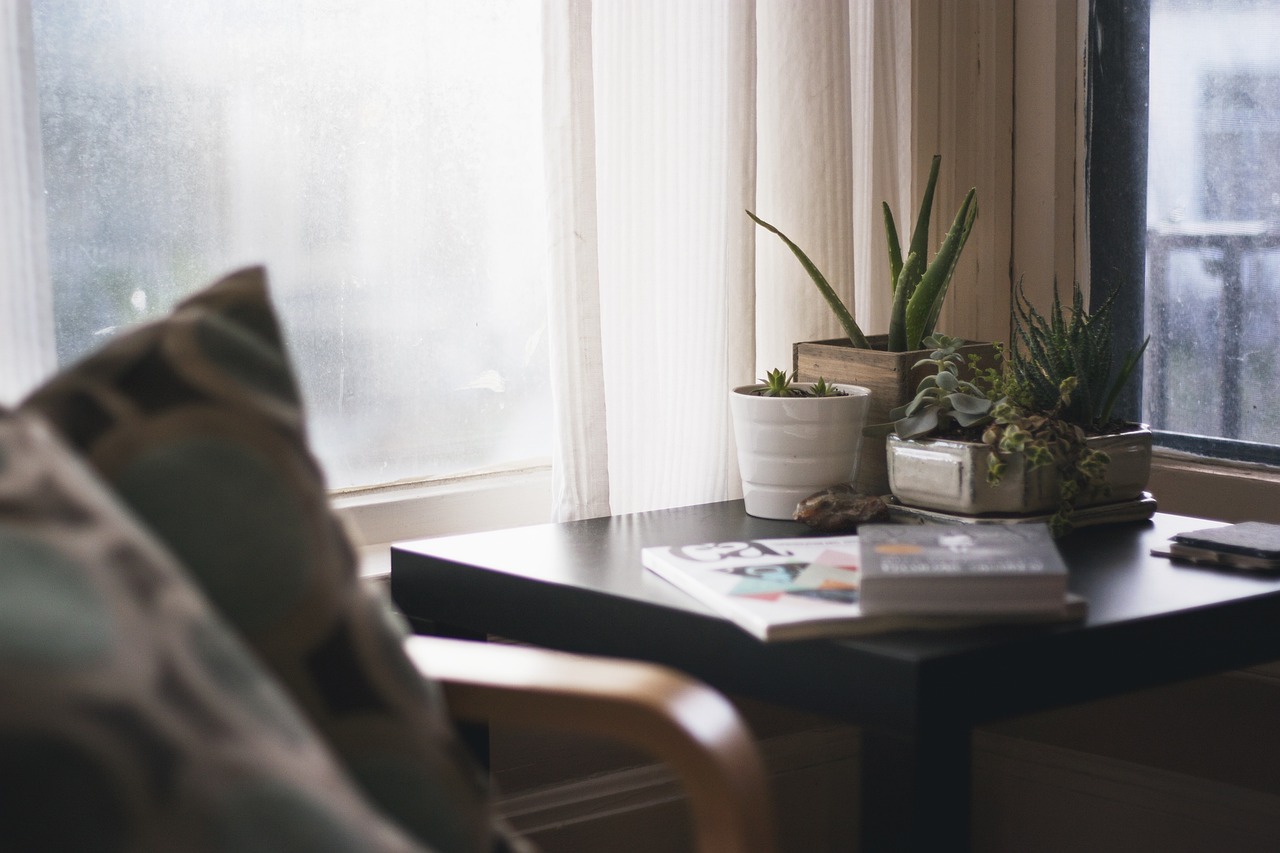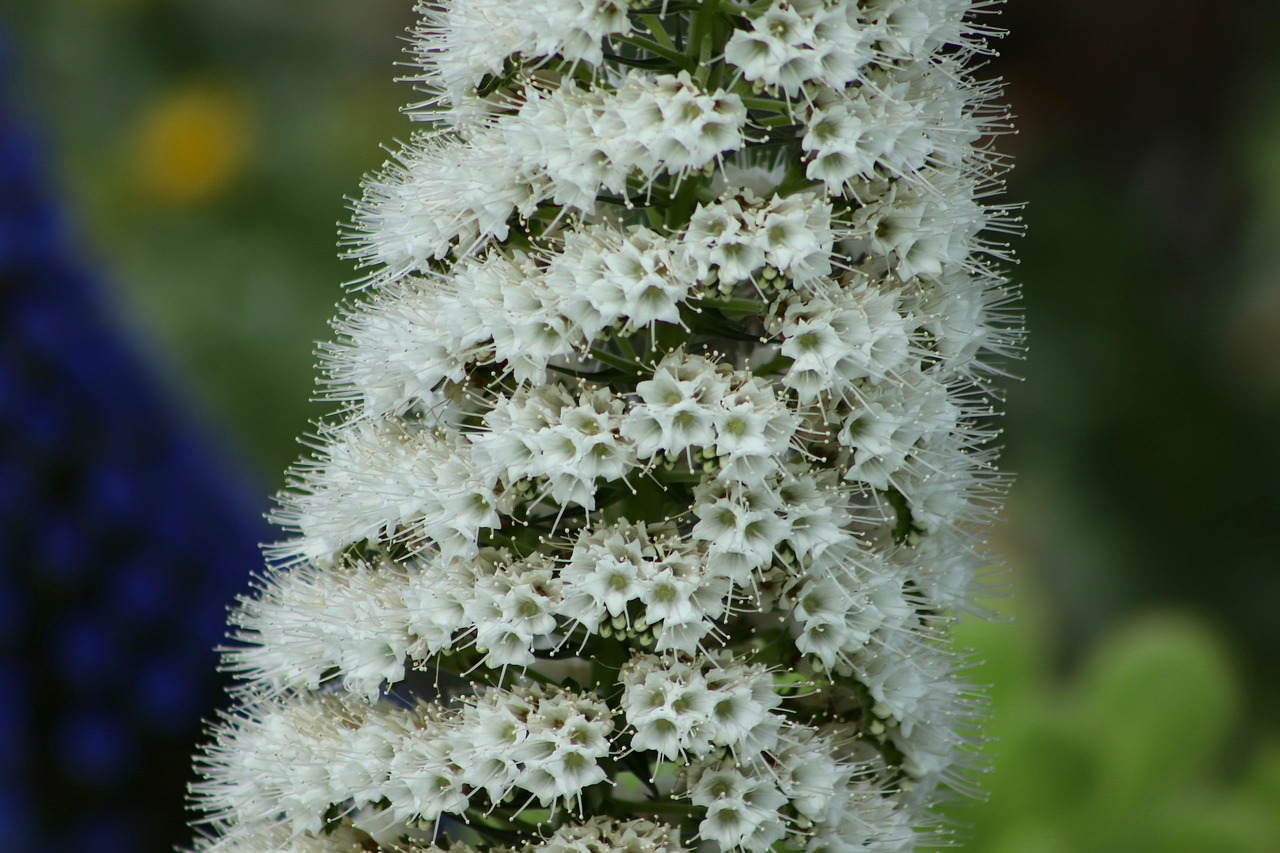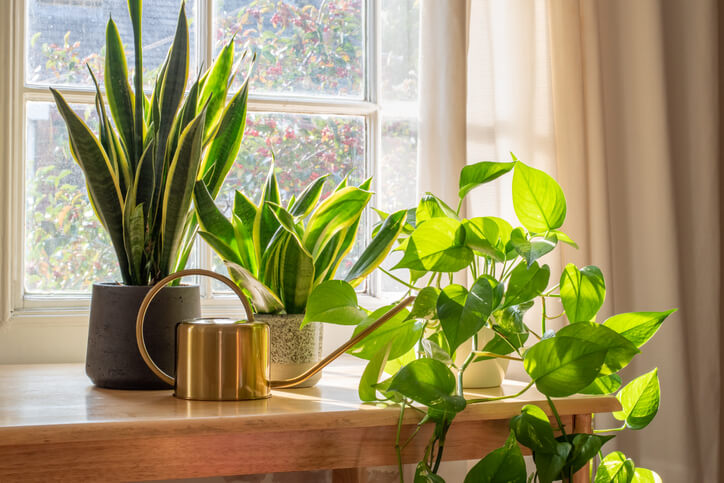Table of Contents
- Improved Air Quality
- Enhanced Relaxation
- Humidity Regulation
- Natural Aromatherapy
- Aesthetically Pleasing
- Choosing the Right Bedroom Plants
- Snake Plant (Sansevieria)
- Lavender (Lavandula)
- Peace Lily (Spathiphyllum)
- Aloe Vera
- Spider Plant (Chlorophytum comosum)
- Jasmine (Jasminum)
- Pothos (Epipremnum aureum)
- Caring for Bedroom Plants
- Provide adequate light based on the plant’s requirements.
Your bedroom is your sanctuary, a place of rest and rejuvenation. Adding indoor plants to your bedroom decor is a wonderful way to enhance the ambiance and promote a healthier living environment. In this article, we’ll explore the benefits of incorporating bedroom plants and provide a list of suitable green companions to transform your sleeping space into a haven of tranquility and well-being.
Your bedroom is your sanctuary, a place of rest and rejuvenation. Adding indoor plants to your bedroom decor is a wonderful way to enhance the ambiance and promote a healthier living environment. In this article, we’ll explore the benefits of incorporating bedroom plants and provide a list of suitable green companions to transform your sleeping space into a haven of tranquility and well-being.
Indoor plants not only breathe life into your surroundings but also purify the air by absorbing toxins and releasing oxygen. Their calming presence and natural beauty create a soothing atmosphere, perfect for unwinding after a long day. We’ll delve into different types of plants, from low-maintenance succulents to leafy greens, to help you choose the best ones that align with your lifestyle and preferences.
Discover the joy of nurturing and caring for these green companions, as they silently contribute to your well-being by reducing stress, improving air quality and even enhancing your focus and creativity. Let’s embark on a journey to invite nature indoors and cultivate a peaceful oasis right in your own bedroom.
Looking for more insights? You’ll find them right here in our extended coverage: Indoor Plants Have Surprising Health Benefits. Here They Are | Time
Improved Air Quality
Indoor plants are natural air purifiers. They absorb carbon dioxide and release oxygen during photosynthesis, which can lead to improved air quality in your bedroom. Some plants, like snake plants and peace lilies, can even filter out common indoor pollutants, including formaldehyde and benzene.
Indoor plants offer a myriad of benefits beyond their aesthetic appeal. They are like living, breathing air purifiers that contribute significantly to the overall well-being of your bedroom environment. Understanding the full scope of their advantages can inspire you to incorporate more greenery into your living space.
As natural air purifiers, indoor plants actively work to improve the air quality in your bedroom. Through the process of photosynthesis, they absorb carbon dioxide and release oxygen, effectively increasing the oxygen levels in your room. This boost in oxygen can lead to better sleep, increased alertness and an overall sense of vitality.
But their air-purifying capabilities go even further. Some specific plants, such as snake plants and peace lilies, have been shown to excel at filtering out common indoor pollutants like formaldehyde, benzene and even volatile organic compounds (VOCs). This natural filtration system not only makes the air in your bedroom feel fresher but also reduces your exposure to potentially harmful substances often found in furniture, paint and cleaning products.
Beyond the science, indoor plants also bring a calming and nurturing element to your bedroom. Their presence can promote relaxation and reduce stress, making your space feel like a tranquil oasis. Taking care of your plants by watering and tending to them can be a therapeutic and meditative practice, further enhancing the peaceful atmosphere of your bedroom.
Incorporating a variety of indoor plants with different shapes and sizes can also add visual interest and texture to your decor. You can choose pots and planters that complement your bedroom’s style, whether it’s modern, rustic or minimalist. The versatility of indoor plants allows you to adapt them to your personal taste and interior design.
In summary, indoor plants are more than just decorative elements; they are essential companions that actively contribute to the quality of your bedroom environment. From purifying the air to promoting relaxation and enhancing the aesthetics of your space, these green allies can play a pivotal role in creating a healthier, more inviting and aesthetically pleasing bedroom retreat. So, consider bringing more of nature’s wonders indoors to reap the numerous benefits they offer.
Looking for more insights? You’ll find them right here in our extended coverage: 20 Best Bedroom Plants for Cleaner Air and Better Sleep

Enhanced Relaxation
The presence of greenery can have a calming effect on the mind. Bedroom plants promote relaxation and reduce stress, helping you unwind after a long day and improve the quality of your sleep.
The calming influence of greenery within your bedroom goes beyond mere aesthetics; it has the power to nurture your well-being and enhance your overall quality of life. Incorporating bedroom plants into your decor not only adds a touch of nature to your living space but also fosters a sense of tranquility and reduces stress levels, thereby promoting relaxation and improving the quality of your sleep.
Improved Air Quality: Bedroom plants play a vital role in purifying the air by absorbing carbon dioxide and releasing oxygen during photosynthesis. This natural air filtration process can help create a cleaner and more oxygen-rich sleeping environment, which can be especially beneficial for those living in urban areas with higher pollution levels.
Stress Reduction: The act of caring for plants, from watering to pruning and repotting, can be a soothing and meditative practice. The rhythmic routine of tending to your green companions can be a form of mindfulness that eases tension and calms the mind. The presence of plants has been shown to lower stress hormone levels, contributing to a more relaxed atmosphere in your bedroom.
Enhanced Relaxation: The visual appeal of lush, green foliage can evoke feelings of tranquility and connection to nature. When you walk into a bedroom adorned with plants, you’re greeted by a sense of serenity and balance. This visual respite from the daily hustle and bustle can be a powerful tool in unwinding after a long day and setting the stage for restful sleep.
Humidity Regulation: Some indoor plants release moisture into the air through a process called transpiration. This natural humidity regulation can be particularly beneficial in dry climates or during the winter months when indoor heating systems tend to dry out the air. Maintaining optimal indoor humidity levels can prevent discomfort caused by dry throat or skin, making your bedroom more conducive to a good night’s sleep.
Aesthetic Appeal: Beyond their therapeutic benefits, bedroom plants can enhance the aesthetics of your space. From small succulents on your nightstand to larger potted plants in cozy corners, they add visual interest and a touch of vitality to your decor. You can choose plants that align with your personal style, whether you prefer the minimalist elegance of snake plants or the lush, bohemian vibe of ferns.
Incorporating bedroom plants into your space is a simple yet powerful way to transform it into a haven of relaxation and rejuvenation. Whether you have a green thumb or are just starting to explore the world of indoor gardening, these botanical companions can become essential elements of your self-care routine, nurturing both your physical and mental well-being while creating a serene retreat that supports a peaceful night’s sleep.
Explore this link for a more extensive examination of the topic: Health and well-being benefits of plants
Humidity Regulation
Many indoor plants release moisture through a process called transpiration. This natural humidifying effect can help maintain optimal humidity levels in your bedroom, especially during dry winter months, which is beneficial for respiratory health.
Harnessing the natural humidifying power of indoor plants can be a transformative addition to your bedroom’s atmosphere, providing a myriad of benefits beyond just improved humidity levels. Here’s an extension of the idea:
Enhancing Air Quality: Indoor plants not only release moisture but also act as natural air purifiers. They can help remove harmful toxins and pollutants from the air, creating a cleaner and fresher bedroom environment. Plants like spider plants, snake plants and peace lilies are known for their air-purifying qualities.
Stress Reduction: The presence of indoor plants can have a calming and stress-reducing effect. Their green foliage and connection to nature can evoke a sense of tranquility, which is especially valuable in a bedroom setting. This can contribute to better sleep quality and overall well-being.
Aesthetic Appeal: Indoor plants can be aesthetically pleasing additions to your bedroom decor. They add a touch of natural beauty and can serve as attractive focal points. Choosing decorative plant pots that match your bedroom’s style can further enhance the visual appeal.
Customized Ambiance: Different plants have different humidity preferences. By selecting a variety of plants with varying moisture-release rates, you can fine-tune the humidity level to your liking. This allows you to create a personalized ambiance in your bedroom, whether you prefer a tropical rainforest-like humidity or a milder, subtler effect.
Low Maintenance Options: If you’re concerned about plant care, there are numerous low-maintenance houseplants that thrive with minimal attention. Succulents and certain varieties of ferns, for example, require infrequent watering and are forgiving if you forget to water them occasionally.
Natural Sleep Aid: Beyond the humidity benefits, some plants, like lavender and jasmine, emit soothing fragrances that are believed to promote relaxation and better sleep. Placing these plants near your bedside can create a natural sleep-enhancing environment.
Connection with Nature: In urban environments, we often become disconnected from nature. Indoor plants provide a tangible link to the natural world, fostering a sense of mindfulness and grounding. Caring for plants can be a meditative and rewarding practice.
Learning and Growth: Incorporating plants into your bedroom can also be an opportunity for personal growth and learning. Observing their growth cycles, understanding their needs and watching them flourish can be a rewarding and educational experience.
Sustainability: Embracing indoor plants is an eco-friendly choice. They contribute positively to the environment by absorbing carbon dioxide and releasing oxygen, making your bedroom a greener, more sustainable space.
In conclusion, indoor plants offer more than just a boost in humidity levels; they enrich your bedroom environment in numerous ways. They improve air quality, reduce stress, enhance aesthetics and connect you with nature. With a wide variety of plant species available, you can tailor your plant selection to create a bedroom oasis that aligns with your unique preferences and contributes to your overall health and well-being.
For a comprehensive look at this subject, we invite you to read more on this dedicated page: Interaction with indoor plants may reduce psychological and …

Natural Aromatherapy
Some plants, such as lavender and jasmine, emit pleasant fragrances that can enhance the aroma of your bedroom. These natural scents promote relaxation and may even contribute to better sleep quality.
Bringing the soothing scents of nature into your bedroom can elevate your sleep environment to a whole new level. Here’s why incorporating fragrant plants like lavender and jasmine is a delightful idea:
1. Lavender’s Tranquil Touch: Lavender, with its gentle and calming scent, has long been associated with relaxation and stress reduction. Having a lavender plant in your bedroom not only adds a touch of natural beauty but also releases its fragrance, which can help reduce anxiety and promote a sense of tranquility. Many people find that the soothing aroma of lavender eases them into a peaceful slumber.
2. Jasmine’s Sweet Dreams: Jasmine is another fragrant gem known for its delicate and sweet scent. The aroma of jasmine is often linked to improved sleep quality and reduced restlessness. Having a jasmine plant near your bedside can fill your bedroom with its enchanting fragrance, creating a serene atmosphere that encourages restful sleep.
3. Improved Air Quality: Beyond their fragrant benefits, plants also contribute to better indoor air quality by purifying the air and releasing oxygen. This can lead to a fresher and more invigorating bedroom environment, making it easier to breathe and sleep comfortably.
4. Low Maintenance: Both lavender and jasmine are relatively low-maintenance indoor plants, making them suitable for even those without a green thumb. They thrive in well-drained soil, require moderate sunlight and only need occasional watering. With proper care, they can thrive and provide fragrant blooms year-round.
5. Customizable Aesthetic: These plants can be incorporated into your bedroom decor seamlessly. Choose pots or planters that match your bedroom’s aesthetic, whether it’s minimalist, rustic or contemporary. The greenery and blooms of lavender and jasmine can add a touch of natural elegance to your space.
6. A Sensory Bedtime Ritual: Incorporating fragrant plants into your bedtime routine can become a soothing ritual. As you water and care for your plants, you engage your senses and signal to your body that it’s time to unwind and prepare for sleep.
7. Variety of Options: While lavender and jasmine are popular choices, there’s a wide variety of fragrant plants to choose from, each with its unique scent and visual appeal. Consider experimenting with different plants to find the fragrance that resonates most with you.
By adding these fragrant plants to your bedroom, you not only infuse your space with natural beauty and pleasant aromas but also create an environment that actively supports relaxation and restorative sleep. The gentle scents of lavender and jasmine become a gentle lullaby that guides you into a peaceful and rejuvenating slumber, night after night.
For additional details, consider exploring the related content available here Do Fake Plants Really Provide the Same Health Benefits as Living …

Aesthetically Pleasing
Plants add a touch of natural beauty to your bedroom decor. They come in a variety of shapes, sizes and colors, allowing you to personalize your space and create a visually pleasing environment.
Certainly, here’s an extended idea:
“Plants are not just decorative elements; they are living, breathing additions to your bedroom decor that can transform your space in more ways than one. These green companions bring a touch of natural beauty and vibrancy to your room, while also offering numerous benefits for your well-being and the overall ambiance of your space.
The versatility of plants is astounding. They come in a wide range of shapes, sizes and colors, making it easy to select the perfect ones to complement your bedroom’s aesthetic. Whether you prefer the tall and elegant grace of a snake plant, the lush and trailing foliage of a pothos or the vibrant blooms of a peace lily, there’s a plant to match every style and personality.
Beyond their aesthetic appeal, plants bring a host of other advantages to your bedroom. One of the most significant benefits is improved air quality. Many common indoor plants are natural air purifiers, filtering out pollutants and toxins from the air. They absorb carbon dioxide and release oxygen, creating a healthier and fresher atmosphere in your room. Breathing cleaner air can lead to better sleep quality and overall well-being.
Plants also have a calming and soothing effect on the mind. The act of caring for them—watering, pruning and observing their growth—can be a meditative practice that helps reduce stress and anxiety. The presence of greenery has been shown to lower cortisol levels and promote relaxation, making it an excellent addition to your sleep sanctuary.
Moreover, plants can enhance the overall ambiance of your bedroom. The soft, organic shapes of leaves and petals contrast beautifully with the rigidity of furniture and decor. They add a sense of tranquility and connection to nature, making your bedroom feel like a peaceful retreat. The play of light on their surfaces during the day and their subtle silhouettes in the evening can create a dynamic and ever-changing visual landscape.
Plants are not just passive decor; they become part of your daily routine and life in your bedroom. You’ll find joy in nurturing them and watching them grow. As they thrive, they add a sense of vitality and energy to your space, creating a harmonious balance between the natural world and your interior design.
In summary, adding plants to your bedroom decor is more than just a design choice; it’s an investment in your well-being and the overall ambiance of your space. These living accessories bring natural beauty, improved air quality and a sense of tranquility to your room. As you select and care for your plants, you’ll find that they not only personalize your space but also become cherished companions in your journey towards a more vibrant and peaceful bedroom.”
To expand your knowledge on this subject, make sure to read on at this location: 7 Science-Backed Benefits of Indoor Plants

Choosing the Right Bedroom Plants
When selecting plants for your bedroom, consider factors like maintenance, light requirements and potential allergens. Here are some popular bedroom plant options to consider:
When it comes to selecting the perfect plants for your bedroom, it’s not just about adding a touch of greenery; it’s about creating a soothing and healthy environment conducive to restful sleep and relaxation. Before you start adding plants to your bedroom oasis, it’s essential to consider a few key factors to ensure your green companions thrive in their new home. Here are some popular bedroom plant options to consider, along with factors you should keep in mind:
1. Peace Lily (Spathiphyllum): Peace lilies are renowned for their air-purifying properties, making them an excellent choice for the bedroom. They can remove toxins from the air, promoting a healthier sleeping environment. Keep in mind that they prefer indirect sunlight and regular watering, but they’re relatively low-maintenance.
2. Snake Plant (Sansevieria): If you’re looking for a virtually indestructible plant, the snake plant is a top pick. It can tolerate low light conditions and doesn’t require frequent watering. This plant also helps improve air quality by removing toxins, making it a practical choice for your bedroom.
3. Aloe Vera: Aloe vera is not only known for its air-purifying qualities but also for its soothing gel, which can be used for minor skin irritations. Place it in a sunny spot, as it loves indirect sunlight. Water it sparingly, as overwatering can lead to root rot.
4. Lavender (Lavandula): Lavender is famous for its calming scent, which can help promote relaxation and sleep. It’s a fragrant herb that thrives in bright sunlight, so a sunny windowsill is an ideal spot. Consider using a pot of dried lavender or lavender essential oils for a more straightforward aromatic experience.
5. Boston Fern (Nephrolepis exaltata): Boston ferns are known for their lush, feathery fronds that can add a touch of elegance to your bedroom. They thrive in high humidity and indirect light. Regular misting and moderate watering will keep them happy and healthy.
6. Jasmine (Jasminum): Jasmine plants not only add beauty to your bedroom with their delicate, fragrant flowers, but they also release a soothing scent that can promote relaxation and reduce stress. They prefer bright, indirect sunlight and slightly moist soil.
7. Spider Plant (Chlorophytum comosum): Spider plants are resilient and adapt well to various light conditions, making them a versatile choice for your bedroom. They are also known for their air-purifying abilities and can help maintain air quality.
8. ZZ Plant (Zamioculcas zamiifolia): The ZZ plant is incredibly low-maintenance, making it an ideal option for those with busy lifestyles. It can tolerate low light and infrequent watering. This plant’s glossy, dark green leaves add a modern touch to your bedroom decor.
Remember, while plants can enhance the ambiance of your bedroom, it’s essential to consider any potential allergies or sensitivities you or your household members may have. Some plants can trigger allergies, so it’s wise to research the specific plant’s pollen and allergen potential before bringing it into your bedroom.
In conclusion, adding plants to your bedroom can breathe new life into your space while providing several health benefits. By selecting plants that align with your maintenance preferences, light conditions and potential allergen concerns, you can create a tranquil and inviting bedroom oasis that promotes relaxation and better sleep quality. So, choose your bedroom plants wisely and let nature’s beauty enhance your sanctuary.
Additionally, you can find further information on this topic by visiting this page: 10 of the Best Plants for the Bedroom | Casper Blog

Snake Plant (Sansevieria)
Known for its air-purifying abilities, the snake plant is easy to care for and thrives in low light conditions. It’s an excellent choice for bedrooms with limited sunlight.
The snake plant, also known as Sansevieria or the mother-in-law’s tongue plant, has garnered a well-deserved reputation for its exceptional air-purifying qualities. Beyond its air-cleansing prowess, this resilient plant boasts another remarkable trait: its ability to thrive in low-light conditions. This makes it an ideal addition to bedrooms that receive limited natural sunlight.
In spaces where the sun’s rays struggle to penetrate, the snake plant stands as a beacon of hope for plant enthusiasts. Its adaptation to low light means you can place it in corners, on shelves or even across the room from the window and it will continue to flourish. This versatility in positioning allows you to maximize the use of your bedroom space without compromising on greenery.
Moreover, the snake plant is renowned for its minimal care requirements. It’s a plant that forgives forgetfulness, making it an excellent choice for those with busy lifestyles or a tendency to neglect their plants occasionally. With infrequent watering and minimal maintenance, you can enjoy the benefits of improved air quality without the stress of high-maintenance plant care.
The snake plant’s lush, vertical leaves not only contribute to a soothing bedroom atmosphere but also lend an elegant touch of green to your decor. Its unique appearance adds a touch of sophistication to any room, making it a versatile choice for a variety of interior styles.
So, if you’ve been longing to introduce some greenery into your bedroom oasis but have been deterred by the lack of natural light, the snake plant is here to answer your call. It brings both beauty and health benefits to your space while accommodating your lifestyle and lighting constraints with ease. Make your bedroom a healthier and more vibrant sanctuary with this remarkable plant.
Looking for more insights? You’ll find them right here in our extended coverage: Best bedroom plants: 10 plants for a peaceful sanctuary |

Lavender (Lavandula)
Lavender not only looks beautiful but also emits a soothing fragrance known for its relaxation and sleep-inducing properties. Place it near your bed for maximum benefit.
Lavender, with its stunning appearance and delightful aroma, serves as both a visual and olfactory treat. Its elegant purple blooms not only enhance the aesthetic appeal of your space but also contribute to a tranquil ambiance. Beyond its visual charm, lavender is renowned for its relaxation and sleep-inducing properties, making it an ideal addition to your bedroom decor.
By placing a lavender plant or a sachet of dried lavender flowers near your bed, you can harness its soothing potential to the fullest. The gentle scent of lavender has been shown to reduce stress and anxiety, helping you unwind after a long day and prepare your mind and body for a restful night’s sleep. As you breathe in the calming fragrance, your senses will gradually be lulled into a state of tranquility, making it easier to achieve a peaceful night’s rest.
Incorporating lavender into your bedroom not only promotes better sleep but also elevates the overall ambiance, creating a serene sanctuary where you can escape the stresses of the day. So, consider adding this fragrant and aesthetic touch to your sleeping space and experience the harmonious blend of beauty and relaxation that lavender offers.
To expand your knowledge on this subject, make sure to read on at this location: Lavender: How to Plant, Grow, and Care for Lavender Flowers | The …

Peace Lily (Spathiphyllum)
Peace lilies are exceptional air purifiers and thrive in low to moderate light. They produce elegant white blooms that can enhance the aesthetics of your bedroom.
Peace lilies, often touted as nature’s own air purifiers, are indeed remarkable additions to your bedroom for several reasons. Their ability to purify the air you breathe and their aesthetic allure make them an ideal choice for creating a tranquil and health-conscious sleep sanctuary. Here’s a more in-depth exploration of why peace lilies are exceptional and how they can elevate both the ambiance and well-being in your bedroom:
Natural Air Filtration: Peace lilies are renowned for their air-purifying qualities. They can effectively filter out common indoor pollutants like formaldehyde, benzene and ammonia, which can be found in various household products and materials. By incorporating peace lilies into your bedroom, you’re investing in cleaner, fresher air that promotes a healthier sleep environment.
Low-Light Adaptability: Peace lilies are known for their resilience in low to moderate light conditions. This adaptability makes them well-suited for bedrooms where bright sunlight may be limited. Their lush, green foliage adds a touch of nature to your space, even in areas with limited natural light.
Minimal Maintenance: Peace lilies are relatively low-maintenance plants. They don’t require frequent watering and are forgiving of occasional neglect. This ease of care ensures that your bedroom remains a stress-free and calming oasis, without the added burden of demanding plant care.
Elegant Blooms: Beyond their air-purifying capabilities, peace lilies produce exquisite white blooms that add a touch of elegance and serenity to your bedroom. These delicate, trumpet-shaped flowers symbolize peace and purity, aligning perfectly with the tranquil ambiance you seek for your sleep space.
Aromatherapy Effect: Some people report a subtle, pleasant fragrance from peace lilies when they bloom. This gentle aroma can contribute to the overall ambiance of your bedroom, providing a mild, natural form of aromatherapy that enhances relaxation.
Moisture Regulation: Peace lilies can help regulate humidity levels in your bedroom. They release moisture into the air through a process called transpiration, which can be especially beneficial in dry indoor environments, preventing issues like dry skin and irritated respiratory passages.
Aesthetic Versatility: Peace lilies come in various sizes, making them suitable for both small and large bedrooms. Their versatile aesthetic blends seamlessly with various decor styles, from minimalist to eclectic, allowing you to personalize your sleep sanctuary.
Biophilic Connection: Incorporating live plants like peace lilies aligns with the biophilic design principle, which suggests that connecting with nature positively impacts well-being. Having a living, breathing element in your bedroom fosters a deeper sense of connection to the natural world.
Stress Reduction: Gardening and tending to plants, including peace lilies, can be a meditative and stress-reducing activity. Spending a few moments caring for your peace lily can serve as a calming bedtime ritual, helping you unwind and prepare for a peaceful night’s sleep.
In summary, peace lilies are more than just decorative houseplants; they are allies in creating a healthy, harmonious and visually pleasing bedroom environment. By enhancing air quality, providing elegant blooms and requiring minimal upkeep, peace lilies contribute to your overall well-being and transform your bedroom into a tranquil oasis where restful sleep comes naturally.
Explore this link for a more extensive examination of the topic: Best bedroom plants: 10 plants for a peaceful sanctuary |

Aloe Vera
Aloe vera is not only useful for its healing properties but also for its ability to remove airborne toxins. It requires minimal maintenance and prefers bright, indirect sunlight.
Aloe vera is not only useful for its healing properties but also for its ability to remove airborne toxins. It requires minimal maintenance and prefers bright, indirect sunlight. Here are some more reasons why incorporating an aloe vera plant into your indoor space is a fantastic idea:
Natural Air Purifier: Aloe vera is a champion in purifying the air. It effectively filters out harmful chemicals like formaldehyde and benzene, which can be found in common household products such as cleaning agents, paints and plastics. This natural air purifier not only improves the air quality in your home but also contributes to a healthier living environment.
Low Maintenance: Aloe vera is known for its resilience and low maintenance requirements. It doesn’t demand constant attention or frequent watering. In fact, overwatering is one of the common mistakes made with aloe vera. Simply let the soil dry out between waterings and your plant will thrive with minimal fuss.
Healing Properties: Beyond its air-purifying abilities, aloe vera leaves contain a gel with well-documented healing properties. It’s a go-to remedy for minor burns, cuts and skin irritations. Having an aloe vera plant at your disposal means you can quickly access natural first-aid for minor injuries.
Aesthetic Appeal: Aloe vera’s distinctive rosette of thick, succulent leaves adds a touch of greenery and visual interest to your indoor space. Its sleek, modern appearance complements a variety of decor styles, making it a versatile choice for any room.
Oxygen Production: Like all plants, aloe vera releases oxygen during photosynthesis. Placing one in your bedroom can enhance oxygen levels, promoting better sleep and overall well-being. Its nighttime oxygen release makes it an ideal bedroom companion.
Easy Propagation: Aloe vera is easy to propagate. As it matures, it produces offsets or “pups” that you can separate and replant in other containers. This means you can expand your collection or share aloe vera plants with friends and family.
Natural Decor Element: Aloe vera effortlessly adds a natural decor element to your living space. It can be placed in various containers or decorative pots to match your style. Its sculptural quality adds a contemporary, organic touch to your home.
Incorporating an aloe vera plant into your indoor environment not only elevates your decor but also contributes to cleaner air, minimal maintenance and the potential for quick, natural healing. It’s a versatile and attractive addition to any room, enhancing both the aesthetic and functional aspects of your living space.
To expand your knowledge on this subject, make sure to read on at this location: 11 Bedroom Plants to Help You Sleep Better – The Sleep Matters Club

Spider Plant (Chlorophytum comosum)
Spider plants are known for their air-cleaning abilities and are safe for homes with pets. They thrive in indirect light and can tolerate occasional neglect.
“Spider plants, scientifically known as Chlorophytum comosum, are indeed remarkable additions to your bedroom for several reasons. Beyond their air-purifying prowess and pet-friendly nature, they offer unique characteristics that make them stand out as ideal bedroom companions:
1. Air-Cleaning Champions: Spider plants are renowned for their exceptional air-cleaning abilities. They can efficiently remove common indoor pollutants, including formaldehyde, xylene and toluene, which may be present in bedroom furnishings or cleaning products. By having a spider plant in your bedroom, you not only enjoy cleaner air but also potentially reduce the risk of health issues related to indoor air pollution.
2. Pet Safety: For households with furry friends, the safety of indoor plants is a paramount concern. Spider plants are non-toxic to cats and dogs, making them a pet-friendly choice. Even if your curious pet decides to take a nibble, spider plants won’t pose a threat to their health.
3. Low Maintenance: Spider plants are renowned for their hardiness and adaptability. They can thrive in a variety of conditions, making them suitable for bedrooms with different lighting situations. While they prefer indirect light, they can tolerate occasional neglect and irregular watering. Their forgiving nature is a boon for those who may not have a green thumb or time for intensive plant care.
4. Aesthetic Appeal: Beyond their practical benefits, spider plants add an aesthetic charm to your bedroom. Their long, arching leaves with variegated patterns create an attractive visual contrast. Whether you place them on a shelf, in a hanging planter or as part of a green corner arrangement, spider plants can be a stylish addition to your bedroom decor.
5. Easy Propagation: Spider plants are prolific producers of “spiderettes” or plantlets. These small offshoots can be easily propagated and potted separately. This not only allows you to expand your collection but also makes spider plants a delightful choice for sharing with friends and family.
6. Promoting Relaxation: The presence of spider plants can contribute to the overall ambiance of your bedroom. The lush greenery and gentle swaying of their leaves can create a calming and serene atmosphere, perfect for relaxation and unwinding after a long day.
Incorporating a spider plant into your bedroom not only enhances the visual appeal but also supports your well-being and the health of your indoor environment. With their air-purifying abilities, pet-friendly nature and ease of care, spider plants are a versatile and valuable addition to your bedroom, contributing to a more pleasant and health-conscious living space.”
For a comprehensive look at this subject, we invite you to read more on this dedicated page: Top 10 Indoor Plants for Increasing Oxygen at Home (2023)

Jasmine (Jasminum)
Jasmine plants produce fragrant white flowers that can promote relaxation and improve sleep quality. They require bright, indirect light to thrive.
Jasmine plants not only add a touch of natural beauty to your home but also offer the incredible benefit of enhancing relaxation and sleep quality through their fragrant white blossoms. Here’s an extended exploration of the idea:
Aromatic Bliss: The delicate, sweet scent of jasmine flowers is known for its calming and soothing properties. The aroma of jasmine has been used for centuries in various cultures to reduce stress, anxiety and promote a sense of tranquility. Having a jasmine plant in your bedroom can create a natural and fragrant atmosphere conducive to relaxation.
Natural Sleep Aid: The calming fragrance of jasmine is believed to have a positive impact on sleep quality. Inhaling the scent before bedtime can help reduce insomnia, improve sleep efficiency and increase overall sleep satisfaction. This natural sleep aid is a wonderful alternative to synthetic sleep-inducing products.
Visual Appeal: Jasmine plants are not only admired for their scent but also for their elegant, glossy green leaves and delicate white flowers. They add a touch of visual appeal to your bedroom decor, enhancing the overall ambiance of the space.
Low Maintenance: Jasmine plants are relatively low maintenance. They thrive in bright, indirect light, making them suitable for various indoor environments. Regular watering and occasional pruning to maintain their shape are typically all that’s needed to keep them healthy and flourishing.
Natural Air Purifiers: Jasmine plants contribute to better indoor air quality by absorbing pollutants and releasing oxygen during photosynthesis. This can help create a healthier sleeping environment, allowing you to breathe easier and sleep more soundly.
Variety of Choices: There are different species of jasmine plants, each with its unique scent and appearance. Some varieties, like Arabian jasmine (Jasminum sambac), are particularly renowned for their fragrance. Explore the options and choose the one that resonates with your preferences.
Customized Arrangements: Get creative with your jasmine plant arrangements. You can place them in decorative pots, hanging baskets or trellises to suit your bedroom’s decor and layout. Training the vines to climb or trail can also add an artistic touch to your space.
Mood Enhancement: Beyond improving sleep quality, jasmine’s scent can positively affect your mood. Its uplifting and stress-relieving qualities can help create a peaceful and harmonious atmosphere in your bedroom, ideal for unwinding after a long day.
Mindful Care: Taking care of a jasmine plant can be a form of mindfulness. Nurturing and observing its growth can offer a sense of connection to nature and a daily reminder to slow down and appreciate the beauty of life.
Gift of Serenity: Consider gifting a potted jasmine plant to a loved one. It’s a thoughtful present that not only adds beauty to their space but also promotes relaxation and well-being.
Incorporating a jasmine plant into your bedroom decor is a natural and budget-friendly way to create a peaceful and serene atmosphere. Beyond its aesthetic appeal, the soothing fragrance of jasmine can transform your bedroom into a tranquil sanctuary, where relaxation and restful sleep are readily embraced.
For a comprehensive look at this subject, we invite you to read more on this dedicated page: 15 Positive Energy Plants That Will Boost Your Mental Health In 2023

Pothos (Epipremnum aureum)
Pothos is a low-maintenance plant that can thrive in various lighting conditions. Its cascading vines add a touch of greenery to your bedroom.
Pothos, often referred to as the “Devil’s Ivy,” is a versatile and low-maintenance plant that can effortlessly thrive in a range of lighting conditions, making it an excellent addition to your bedroom decor. Its resilience and adaptability make it a top choice for both seasoned plant enthusiasts and beginners alike.
Whether your bedroom is bathed in natural sunlight or tends to be on the darker side, the pothos can flourish. It can tolerate low light environments, making it an excellent choice for bedrooms with limited windows or where indirect sunlight is the norm. In brighter spaces, it showcases vibrant, variegated leaves that catch the light beautifully, adding a touch of natural elegance to your room.
The beauty of the pothos lies not only in its adaptability but also in its lush, cascading vines. You can place it in a hanging planter or on a high shelf, allowing its vines to gracefully drape down, creating a captivating visual display. This greenery not only enhances the aesthetics of your bedroom but also adds a calming and soothing element to your environment, promoting a sense of tranquility and well-being.
Beyond its aesthetics, pothos offers additional benefits for your bedroom. It’s known for its air-purifying qualities, helping to remove common indoor pollutants and improve the overall air quality in your sleeping space. This can contribute to a more restful and rejuvenating sleep experience.
Taking care of a pothos plant is a breeze. It requires minimal attention, with watering needed only when the soil feels dry to the touch. It’s a forgiving plant that can withstand occasional neglect, making it an ideal choice for those with busy lifestyles.
Incorporating a pothos plant into your bedroom decor is a simple yet effective way to breathe life and vitality into your personal sanctuary. Its adaptability, visual appeal, air-purifying qualities and low-maintenance nature make it a green companion that enhances your bedroom’s ambiance while promoting a sense of calm and well-being.
Don’t stop here; you can continue your exploration by following this link for more details: 10 Best Bedroom Plants | DreamCloud

Caring for Bedroom Plants
To keep your bedroom plants healthy, follow these general care tips:
Water your plants according to their specific needs; avoid overwatering or allowing them to sit in standing water.
Ensuring the well-being of your bedroom plants goes beyond aesthetics; it contributes to a healthier and more vibrant environment. Here are some essential tips to maintain the lushness and vitality of your indoor green companions:
Know Your Plants: Different plants have different water requirements. Take the time to research the specific needs of each plant in your bedroom. Some, like succulents, prefer to dry out between waterings, while others, like ferns, thrive in consistently moist soil.
Observe and Adjust: Pay attention to your plants and adjust your watering routine accordingly. Rather than sticking to a strict schedule, observe the soil’s moisture level and the plant’s overall health. If the top inch or two of soil feels dry, it’s typically time to water.
Use the Right Watering Technique: When it’s time to water, do so thoroughly. Water the soil until it’s evenly moist, allowing excess water to drain away. Avoid watering just the surface, as this can lead to shallow root growth.
Choose the Right Pots: Select pots or containers with drainage holes. Proper drainage is crucial to prevent water from pooling at the bottom, which can lead to root rot. Use a saucer or tray beneath the pot to catch excess water.
Watering Tools: Invest in a watering can with a narrow spout or a spray bottle for precise and controlled watering. This allows you to water the soil directly at the base of the plant and avoid splashing water on the leaves, which can lead to fungal issues.
Avoid Standing Water: Ensure that your pots and containers don’t sit in standing water for extended periods. Empty the saucers beneath the pots after watering to prevent the roots from becoming waterlogged.
Consistent Environment: Maintain a consistent indoor environment for your plants. Avoid placing them in drafty areas or near radiators or air conditioning units, as rapid temperature fluctuations can stress plants and increase their water requirements.
Humidity Levels: Some indoor plants, especially tropical varieties, thrive in higher humidity levels. Consider using a humidity tray, a humidifier or misting the leaves regularly to create a more favorable environment.
Fertilization: While proper watering is essential, don’t forget to feed your plants. Use a balanced, water-soluble fertilizer during the growing season to provide the necessary nutrients for healthy growth.
Prune and Groom: Regularly prune dead or yellowing leaves and remove spent flowers. This not only improves the plant’s appearance but also redirects energy toward healthy growth.
Repot When Needed: As your plants grow, they may become root-bound or outgrow their containers. When you notice this happening, consider repotting into a slightly larger container with fresh potting mix.
Keep an Eye on Pests: Be vigilant for signs of pests, such as discolored or damaged leaves. If you suspect an infestation, take prompt action to address the issue using natural remedies or commercial insecticides if necessary.
By applying these general care tips and tailoring them to the specific needs of your bedroom plants, you’ll create an environment where your green companions can thrive. With proper care, your indoor plants will not only enhance the beauty of your space but also contribute to a healthier and more tranquil atmosphere in your bedroom.
You can also read more about this here: 7 Science-Backed Benefits of Indoor Plants

Provide adequate light based on the plant’s requirements.
Prune and dust the plants regularly to ensure they remain vibrant and clean.
Repot when necessary to allow for growth and prevent root-bound conditions.
Watch for signs of pests or disease and address them promptly.
Caring for your indoor plants goes beyond just placing them in a nice spot. It involves consistent attention and care to keep them thriving. Here’s an extended guide on maintaining your indoor plants:
Choose the Right Plants: Begin by selecting plants that are suitable for your indoor environment. Different plants have varying light and humidity requirements, so make sure you understand the needs of your specific plants to provide the best care.
Regular Pruning: Pruning is essential for maintaining the shape and health of your plants. Remove dead or yellowing leaves and trim leggy growth to encourage bushier, more compact growth. This also helps improve air circulation and reduces the risk of disease.
Dusting and Cleaning: Dust can accumulate on your plant’s leaves, hindering their ability to photosynthesize effectively. Wipe the leaves gently with a damp cloth or sponge to keep them clean and allow optimal light absorption.
Water Wisely: Overwatering is one of the most common causes of indoor plant problems. Water your plants when the top inch or two of soil feels dry to the touch. Ensure proper drainage by using pots with drainage holes and always empty the saucers to prevent root rot.
Fertilize Appropriately: Indoor plants benefit from periodic fertilization. Use a balanced, water-soluble fertilizer during the growing season (spring and summer) but reduce or eliminate fertilization during the dormant months (fall and winter).
Repot When Needed: As your plants grow, they may become root-bound in their current pots. Check the roots periodically; if they have filled the pot and are circling tightly, it’s time to repot into a slightly larger container. This provides more space for growth and fresh soil nutrients.
Choose the Right Potting Mix: Different plants have different soil preferences. Use a well-draining potting mix tailored to your plant’s needs, whether it’s cactus mix, succulent mix or a general-purpose mix. Consider adding perlite or vermiculite to improve drainage.
Monitor Humidity: Some indoor plants, particularly tropical varieties, thrive in high humidity. Increase humidity by misting the leaves, using a humidity tray with water and pebbles or placing a humidifier nearby. This helps prevent dry, brown leaf edges.
Inspect for Pests: Regularly inspect your plants for signs of pests like aphids, mealybugs or spider mites. If you notice any infestations, isolate the affected plant and treat it promptly with insecticidal soap or neem oil. Quarantining the plant prevents the infestation from spreading to others.
Rotate for Balanced Growth: Turn your plants regularly to ensure even growth. This prevents them from leaning toward the light source and promotes balanced development.
Temperature Considerations: Be mindful of temperature fluctuations. Most indoor plants thrive in a stable temperature range, so avoid placing them near drafts, radiators or heating/cooling vents.
Be Patient: Plants take time to adapt and grow. If your plant is not thriving immediately, be patient and make gradual adjustments to their care routine. Avoid making too many changes at once.
Seek Advice: If you’re unsure about the care requirements of a specific plant, consult plant care guides or reach out to local nurseries or online plant communities for advice from experienced plant enthusiasts.
By following these comprehensive care guidelines, you’ll create a healthier and more vibrant environment for your indoor plants. Regular attention and proactive measures will help your plants not only survive but also flourish, bringing natural beauty and improved air quality to your living spaces.
To delve further into this matter, we encourage you to check out the additional resources provided here: 20 Best Bedroom Plants for an Oxygen Boost at Night
Bedroom plants are more than just decor; they are living companions that contribute to a calming and healthful environment. With a little care and attention, these green additions can transform your bedroom into a tranquil oasis where you can relax, recharge and enjoy the many benefits of nature indoors. So, consider adding some greenery to your sleeping space and experience the positive impact it can have on your well-being.
Adding plants to your bedroom is like inviting a slice of nature’s serenity into your personal sanctuary. Beyond being decorative elements, these leafy companions offer numerous advantages that enhance your well-being and create a harmonious ambiance. Let’s delve deeper into the many benefits of bedroom plants:
1. Improved Air Quality:
Plants are natural air purifiers, absorbing carbon dioxide and releasing oxygen during photosynthesis. Some species, like snake plants and peace lilies, can also remove common indoor pollutants, such as formaldehyde and benzene, from the air. This leads to cleaner, fresher air in your bedroom, which can contribute to better sleep and overall health.
2. Enhanced Relaxation:
The presence of greenery in your bedroom has a calming effect on the mind. Studies have shown that interacting with indoor plants or simply gazing at them can reduce stress levels, lower blood pressure and promote relaxation. Your bedroom becomes a soothing retreat where you can escape the pressures of the day.
3. Mood Enhancement:
Living among plants can boost your mood and increase feelings of happiness. The sight of vibrant green leaves and the act of caring for your plants can release endorphins, which are natural mood lifters. This positive energy can carry into your daily life, starting with a refreshed outlook each morning.
4. Humidity Regulation:
Many houseplants release moisture into the air through a process called transpiration. This natural humidity control can be especially beneficial in dry indoor environments, preventing issues like dry skin and respiratory discomfort. A more comfortable humidity level also promotes better sleep.
5. Visual Appeal:
Plants add aesthetic beauty and softness to your bedroom decor. They come in a wide range of shapes, sizes and textures, allowing you to choose plants that align with your style and color preferences. Whether you prefer the lush foliage of tropical plants or the simplicity of succulents, there’s a plant to match your bedroom’s aesthetics.
6. Better Sleep Quality:
In addition to purifying the air, some plants release oxygen at night, which can enhance the quality of your sleep. Plants like aloe vera, spider plants and lavender emit oxygen during the nighttime hours, potentially helping you breathe easier and sleep more soundly.
7. Connection with Nature:
Having plants in your bedroom fosters a connection with the natural world, even in an urban setting. This connection can ground you, reduce feelings of isolation and remind you of the beauty and wonder of the natural world.
8. Minimal Maintenance:
Many indoor plants are relatively low-maintenance and require only basic care, such as regular watering and occasional pruning. Even if you don’t have a green thumb, you can find plants that suit your lifestyle and schedule.
In conclusion, bedroom plants offer a multitude of benefits that extend far beyond mere decoration. They create a calming, healthful and visually pleasing environment, making your bedroom a tranquil oasis for rest and relaxation. Whether you’re a seasoned plant enthusiast or a novice, introducing a few green companions into your sleeping space can positively impact your well-being and contribute to a more harmonious and rejuvenating atmosphere. So, why not bring a touch of nature into your bedroom and experience the remarkable transformation it can bring to your life?
Don’t stop here; you can continue your exploration by following this link for more details: Biophilia: Does Visual Contact with Nature Impact on Health and …
More links
Looking for more insights? You’ll find them right here in our extended coverage: Interaction with indoor plants may reduce psychological and …
